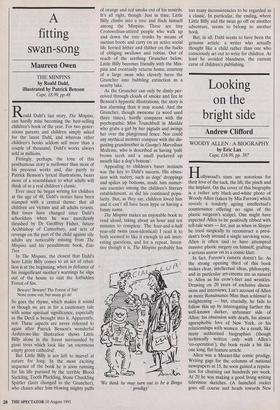A fitting swan-song
Maureen Owen
THE MINPINS by Roald Dahl, illustrated by Patrick Benson Cape, £8.99, pp.48 oald Dahl's last story, The Minpins, can hardly miss becoming the best-selling children's book of the year. For two gener- ations parents and children simply asked for the latest Dahl, and whereas other children's books seldom sell more than a couple of thousand, Dahl's works always sold in millions.
Fittingly, perhaps, the tone of this posthumous story is mellower than most of his previous works and, due partly to Patrick Benson's lyrical illustrations, bears more of a resemblance to what adults will think of as a real children's classic.
Ever since he began writing for children at the age of 48, Dahl's stories have been stamped with a central theme: that all children are victims and all adults tyrants. But times have changed since Dahl's schooldays when he was mercilessly thrashed by Dr Geoffrey Fisher, future Archbishop of Canterbury, and acts of revenge on the part of the child against vile adults are noticeably missing from The Minpins and his penultimate book, Esio Trot.
In The Minpins, the closest that Dahl's hero Little Billy comes to an act of rebel- lion is at the beginning, when in defiance of his insignificant mother's warnings he slips out of the house to visit the forbidden Forest of Sin.
Beware! Beware! The Forest of Sin!
None come out, but many go in!
So goes the rhyme, which makes it sound as though we are in for a cautionary tale with some spiritual significance, especially as the Devil is brought into it. Apparently, not. These aspects are never referred to again after Patrick Benson's wonderful Ardizzone-like illustration shows Little Billy alone in the forest surrounded by giant trees which look like 'an enormous empty green cathedral'.
But Little Billy is not left to marvel at nature for long. In the most exciting sequence of the book he is soon running for his life pursued by the terrible Blood Suckling, Tooth Pluckling, Stone Chuckling Spittler (later changed to the Gruncher), who chases after him blowing mighty puffs
of orange and red smoke out of his nostrils. It's all right, though. Just in time, Little Billy climbs into a tree and finds himself among the Minpins. These are tiny Cromwellian-attired people who walk up and down the tree trunks by means of suction boots and carry on an active social life ferried hither and thither on the backs of obliging swallows and robins. Out of reach of the seething Gruncher below, Little Billy becomes friendly with the Min- pins and eventually returns home, courtesy of a large swan who cleverly lures the Gruncher into bubbling extinction in a nearby lake.
As the Gruncher can only be dimly per- ceived through clouds of smoke and fire in Benson's hypnotic illustrations, the story is less alarming than it may sound. And the Gruncher, though awesome (a word used three times), hardly compares with the psychopathic Miss Trunchbull in Matilda who grabs a girl by her pigtails and swings her over the playground fence. Nor could any mythical monster compare with the dis- gusting grandmother in George's Marvellous Medicine, who is described as having 'pare brown teeth and a small puckered up mouth like a dog's bottom'.
Appealing to children's baser instincts was the key to Dahl's success. His obses- sion with rudery, such as dogs' droppings and spikes up bottoms, made him numer- ous enemies among the children's literary establishment, as did his continued popu- larity. But, as they say, children loved him and it can't all have been hype or having a funny name.
The Minpins makes an enjoyable book to read aloud, taking about an hour and ten minutes to complete. The four-and-a-half year-old twins (non-identical) I read it to both seemed to like it enough to ask inter- esting questions, and for a repeat. Inven- tive thdugh it is, The Minpins probably has `We think he may turn out to be a Bingo prodigy'
too many inconsistencies to be regarded as a classic. In particular, the ending, where Little Billy and the swan go off on another adventure, seems to belong to another book.
But, in all, Dahl seems to have been the genuine article: a writer who actually thought like a child rather than one who consciously set out to write for children. At least he avoided blandness, the current curse of children's publishing.


















































 Previous page
Previous page